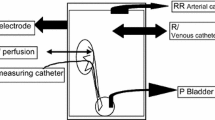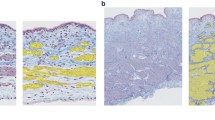Abstract
Spontaneous resolution of intrauterine pelvic dilatations after birth is an expected outcome. In nonobstructive pelvic dilatations, changes in ureteral and bladder physiology may also play a part. We aimed to demonstrate the effect of increased concentrations of bilirubin on ureteral and bladder muscles in vitro. Normal and pathologic concentrations of bilirubin (3.5×10-7–10-5M and 10-4–4×10-4M, respectively) caused no change in the basal ureter tension (343.9±29.4 mg). Normal concentrations of bilirubin caused no difference in basal bladder tension (430.2±70.2 mg), but pathologic concentrations caused a decrease of 303.8±52.9 mg. Normal and pathologic amounts of bilirubin were cumulatively applied to rabbit ureteral and bladder tissues both after reaching basal tension and when contracted with KCl (80 mM and 120 mM KCl for ureter and bladder, respectively). The cumulative addition of normal bilirubin concentrations to the ureteral tissues precontracted with KCl produced 86.4±7.2% relaxation, while the addition of pathologic bilirubin concentrations produced a relaxation of 133.9±17.4%, which was significantly higher (p=0.04). Similarly, the addition of normal concentrations of bilirubin to the bladder tissues precontracted with KCl produced a maximal relaxation of 35.3±2.2%, while pathologic concentrations produced a maximal relaxation of 53.5±3.5%, which was significantly higher (0.001). Consequently, high concentrations of bilirubin caused a mild relaxation in basal ureteral and bladder tensions, while pathologically increased concentrations led to significant relaxation in both types of precontracted tissues. We suggest that high bilirubin levels may partly but not directly contribute to the spontaneous recovery of hydronephrosis because of the relaxation effect on bladder while probably causing susceptibility to urinary tract infections because of relaxation of both ureteral and bladder tissues.


Similar content being viewed by others
References
Shokeir AA, Nijman RJ (2000) Antenatal hydronephrosis: changing concepts in diagnosis and subsequent management. BJU Int 85(8):987–994
Koff SA (2000) Postnatal management of antenatal hydronephrosis using an observational approach. Urology 55(5):609–611
Wollenberg A, Neuhaus TJ, Willi UV, Wisser J (2005) Outcome of fetal renal pelvic dilatation diagnosed during the third trimester. Ultrasound Obstet Gynecol 25(5):483–488
Woodward M, Frank D (2002) Postnatal management of antenatal hydronephrosis. BJU Int 89:149–156
Gonzalez R, Schimke CM (2001) Ureteropelvic junction obstruction in infants and children. Pediatr Clin North Am 48:1505–1518
Stoll BJ, Kliegmen RM (2004) Jaundice and hyperbilirubinemia in the newborn. In: Behrman RE, Kliegman RM, Jenson HB (eds) Nelson textbook of pediatrics, 17th edn. Saunders, Philadelphia, 592–599
Tomiyama Y, Hayakawa K, Shinagawa K, Akahane M, Ajisawa Y, Park Y-C, Kurita T (1998) Beta-Adrenoceptor subtypes in the ureteral smooth muscle of rats, rabbits and dogs. Eur J Pharmacol 352:269–278
Rizk DEE, Arafat K, El-Sharkawy TY (2001) Comparison of the inhibitory effects of cromakalim and pinacidil (potassium channel openers) with those of oxybutynin on stimulated guinea pig and rabbit detrusor muscle strips. Arch Gynecol Obstet. 265:141–147
Mayer M (2000) Association of serum bilirubin concentration with risk of coronary artery disease. Clin Chem 46:1723–1727
Kawamura K, Ishikawa K, Wada Y, Kimura S, Matsumoto H, Kohro T, Itabe H, Kodama T, Maruyama Y (2005) Bilirubin from heme oxygenase-1 attenuates vascular endothelial activation and dysfunction. Arterioscler Thromb Vasc Biol 25:155–160
Colpaert EE, Lefebvre RA (2000) Influence of bilirubin and other antioxidants on nitrergic relaxation in the pig gastric fundus. Br J Pharmacol 129(6):1201–1211
Santicioli P, Maggi CA (1998) Myogenic and neurogenic factors in the control of pyeloureteral motility and ureteral peristalsis. Pharmacol Rev 50(4): 683–722
Shafik A (1998) Effect of renal pelvic distension on the ureteropelvic and ureterovesical junctions and the urinary bladder: the renal pelvivesical reflex. World J Urol 16:219–223
Lang RJ, Davidson ME, Exintaris B (2002) Pyeloureteral motility and ureteral peristalsis: essential role of sensory nerves and endogenous prostaglandins. Exp Physiol 87:129–146
Rolle U, Brylla E, Chertin B, Cascio S, Puri P (2003) The intramural innervation of the rabbit upper urinary tract. APMIS Suppl 109:18–22
Shafik A (1997) Pelviureteral inhibitory reflex and ureteropelvic excitatory reflex: role of the two reflexes in regulation of urine flow from the renal pelvis to the ureter. Neurourol Urodyn 16:315–324
Constantinou CE (1974) Renal pelvic pacemaker control of ureteral peristaltic rate. Am J Physiol 226:1413–1419
Maisels MJ, Newman TB (2003) Neonatal jaundice and urinary tract infections. Pediatrics 112:1213–1214
Sarici SU, Kul M, Alpay F (2003) Neonatal jaundice coinciding with or resulting from urinary tract infections? Pediatrics 112:1212–1213
Bullock AJ, Wray S (1998) Developmental and species differences in the response of the ureter to metabolic inhibition. Pflugers Arch 436:443–448
Akimoto M, Biancani P, Weiss RM (1977) Comparative pressure-length-diameter relationships of neonatal and adult rabbit ureters. Invest Urol 14:297–300
Longhurst P (2004) Developmental aspects of bladder function. Scand J Urol Nephrol Suppl 215:11–19
Author information
Authors and Affiliations
Corresponding author
Rights and permissions
About this article
Cite this article
Murat, N., Kasap, B., Kavukcu, S. et al. In vitro analysis of the effect of hyperbilirubinemia on rabbit ureter and bladder. Pediatr Nephrol 21, 328–332 (2006). https://doi.org/10.1007/s00467-005-2094-3
Received:
Revised:
Accepted:
Published:
Issue Date:
DOI: https://doi.org/10.1007/s00467-005-2094-3




